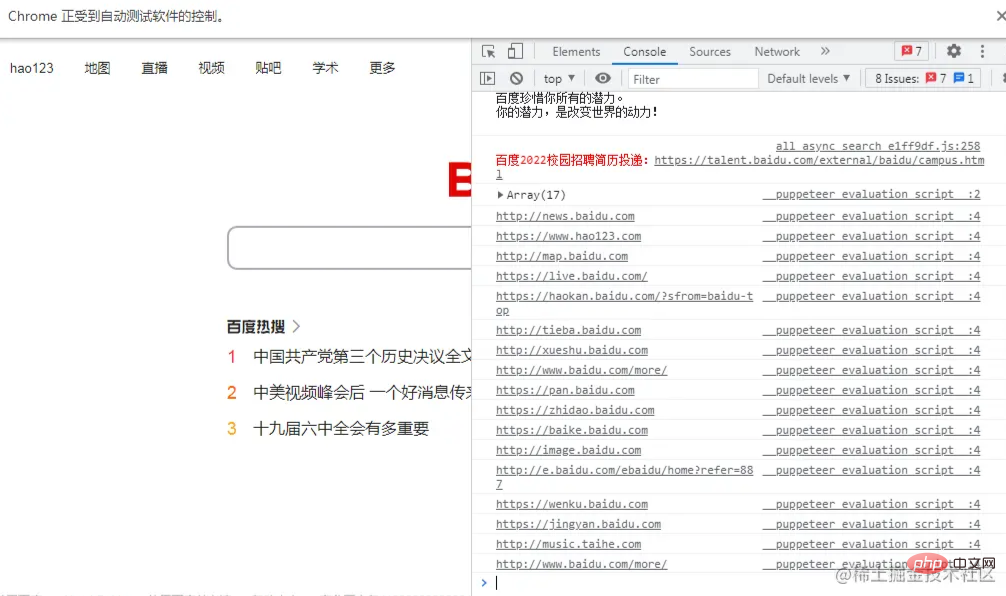
What is the Puppeteer library? What can be done? how to use? The following article will introduce you to the Puppeteer library and learn how to use the Puppeteer library in Node.js. I hope it will be helpful to you!

Puppeteer is a officially produced by Google that controls headless Chrome through the DevTools protocol Node Library. You can directly control Chrome through the API provided by Puppeteer to simulate most user operations to perform UI Test or access the page as a crawler to collect data. Chinese documentation
https://zhaoqize.github.io/puppeteer-api-zh_CN/#/
Puppeteer is an npm package, so the installation is very simple:
npm i puppeteer
or
yarn add puppeteer
How to use:
// 引入 Puppeteer 模块
let puppeteer = require('puppeteer')
//puppeteer.launch实例化开启浏览器
async function test() {
//可以传入一个options对象({headless: false}),可以配置为无界面浏览器,也可以配置有界面浏览器
//无界面浏览器性能更高更快,有界面一般用于调试开发
let options = {
//设置视窗的宽高
defaultViewport:{
width:1400,
height:800
},
//设置为有界面,如果为true,即为无界面
headless:false,
//设置放慢每个步骤的毫秒数
slowMo:250
}
let browser = await puppeteer.launch(options);
// 打来新页面
let page = await browser.newPage();
// 配置需要访问网址
await page.goto('http://www.baidu.com')
// 截图
await page.screenshot({path: 'test.png'});
//打印pdf
await page.pdf({path: 'example.pdf', format: 'A4'});
// 结束关闭
await browser.close();
}test()
// 获取页面内容
//$$eval函数,使回调函数可以运行在浏览器中,并且可以通过浏览器的方式进行输出
await page.$$eval('#head #s-top-left a',(res) =>{
//console.log(res);
res.forEach((item,index) => {
console.log($(item).attr('href'));
})
})
// 监听console.log事件
page.on('console',(...args) => {
console.log(args);
})
// 获取页面对象,添加点击事件
ElementHandle = await page.$$('#head #s-top-left a')
ElementHandle[0].click();
// 通过表单输入进行搜索
inputBox = await page.$('#form .s_ipt_wr #kw')
await inputBox.focus() //光标定位在输入框
await page.keyboard.type('Node.js') //向输入框输入内容
search = await page.$('.s_btn_wr input[type=submit]')
search.click() //点击搜索按钮
Crawler practice
Many web pages use user-agent to determine the device. You can use page.emulate(options) to perform simulation. options has two configuration items, one is userAgent, the other is viewport You can set width(width), height(height) , Screen scaling (deviceScaleFactor), Whether it is a mobile terminal (isMobile), Whether there is a touch event (hasTouch).
const puppeteer = require('puppeteer');
const devices = require('puppeteer/DeviceDescriptors');
const iPhone = devices['iPhone 6'];
puppeteer.launch().then(async browser => {
const page = await browser.newPage();
await page.emulate(iPhone);
await page.goto('https://www.example.com');
// other actions...
await browser.close();
});The above code simulates iPhone6 visiting a website, where devices is the simulation parameters of some common devices built into puppeteer.
Many web pages require login. There are two solutions:
#Tip: Some websites need to scan codes, but other webpages with the same domain name are logged in. You can try to log in to the webpage where you can log in and use cookies to access the jump. Scan the code.
For more powerful functions, please refer to the official documentation: https://zhaoqize.github.io/puppeteer-api-zh_CN/#/
More nodes For related knowledge, please visit: nodejs tutorial! !
The above is the detailed content of A brief analysis of how to use the Puppeteer library in Node.js. For more information, please follow other related articles on the PHP Chinese website!